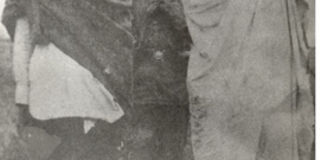Kabalega is released after 23 years of incarceration

Kabaka Mwanga (L) and Omukama Kabalega (R).
What you need to know:
Part III. While at Mahé on the Seychelles Islands, Kabalega was not put in an ordinary jail. He was put under house arrest and was even allowed to enjoy conjugal rights.
That was why he was able to father three children in the 23 years he was there under captivity, Faustin Mugabe writes.
Some 120 years ago, Omukama (king) Kabalega of Bunyoro was exiled to the Seychelles Islands in the Indian Ocean.
He had on April 1899 been arrested from the battlefield at Kangai, now Dokolo District, in northern Uganda by a force composed of Baganda and Nubian soldiers led by a British soldier, Col Colville Evatts.
In May 1899, Kabalega and Kabaka Mwanga of Buganda were forced to exile by the British imperialists. The two were first exiled in Kismayu, Somalia. But when the British got intelligence that the Abarusuura, the Bunyoro Kingdom special forces, were contemplating a rescue mission, the British decided to transferred the two kings to Seychelles Islands, where the Indian Ocean provided a natural defence barrier from any military invaders.
It should be noted that while at Mahé on the Seychelles Islands, Kabalega was not put in an ordinary jail. He was put under house arrest and was even allowed to enjoy his conjugal rights.
That was why he was able to father three children from three different women in the 23 years he was there under captivity.
It is said that Kabaka Mwanga also fathered a girl from a woman only identified as Salimah. The said girl, however, died in 1903, the same year that Mwanga died.
Mwanga died in 1903 and his body was brought back and buried at Kasubi, Buganda’s royal tombs in Kampala, in August 1910.
Kabalega turns to God
While in captivity, Kabalega finally accepted Jesus Christ. It was after all hope of ever returning home alive was lost that Kabalega gave his life to Christ in 1907.
It took more than two years for a preacher to convince Kabalega to accept that the Lord God in Heaven was omnipotent.
Since 1901 when Kabalega was taken to the Seychelles Islands, he was allowed visitors from Bunyoro. And in 1905, a Munyowe missionary only identified as Absolom, who was also a childhood friend of Kabalega, travelled from Bunyoro to visit Kabalega in prison.
It is said that Absolom, who had earlier converted to Christianity, went with his wife. Every day, for more than two years, Absolom preached to Kabalega about accepting Christ. And for those years Kabalega listened and contemplated accepting Christianity.
Finally in 1907, Kabalega accepted that God was supreme to all and he was baptised John. Later, when visitors returning from the Seychelles told the Banyoro that Kabalega had converted to Christianity, the Banyoro accepted Christianity in big numbers.
Many Banyoro had since 1900 abandoned or refused to convert to Christianity because they saw it as a religion of their oppressors and persecutors of their king, Kabalega.
Kabalega set free
On February 14, 1923, the British released Kabalega and allowed him to return home. He was put on a ship that transported him to Port Mombasa, Kenya. Details of who booked him a train ticket and how he travelled from Mombasa to Jinja in eastern Uganda are sketchy.
What is clear, however, is that from Mombasa to Jinja, he travelled by train. The trained arrived in Jinja on February 27, 1923. The news of his arrival in Busoga sub-region was both a shock and joy to the population.
At 70 years, other than suffering from poor eye sight, Kabalega was as fit as a 50-year-old man of the time. It is said that the Basoga, the ‘cousins’ of the Banyoro, cordially welcomed him and the chiefs advised him not to proceed to Bunyoro through Buganda Kingdom.
Kabalega was also not sure of his safety in Buganda which he had for years fought and defeated. But also, it was Semei Kakungulu, a Muganda and British collaborator, who helped the colonialists arrest him during the battle of Kangai.
Kabalega dies mysteriously
In Busoga, Kabalega felt safe. It is also said that the Basoga assured him of safety while in their territory. They went on to accommodate him in their individual homes.
But there was a fear of reaction from Bunyoro Kingdom as well as the British colonial government in Kampala.
Nonetheless, an emissary was sent to Bunyoro to inform the reigning king, Duhaga, of the return of Kabalega. Partly because of that, Kabalega was delayed and he stayed at Mpumudde village, Jinja District, for at least 40 days.
On April 5, 1923, Kabalega’s granddaughters, Komuntale and Komukyeya, and their escorts arrived at Mpumudde from the Bunyoro palace in Hoima.
The daughters of king Duhaga brought skimmed milk, amacunde, which was one of Kabalega’s favourites. It is said that Kabalega was ecstatic. He took the milk. But afterwords, he started vomiting and complaining of stomach pain.
The following day, on April 6, 1923, Kabalega passed on.
Burial
Not even Kabalega’s body could risk passing through Buganda. It was put on a casket and taken by road to Namasagali Port in Kamuli from where it was sailed across the River Nile to Port Masindi in Bunyoro.
From there, it was taken to Mparo in Hoima where his son King Duhaga had decreed that he be buried since Bunyoro’s royal burial grounds in Bugangaizi County had been given to Buganda by the British as a reward for Buganda providing fighters during the British war against Kabalega.
Next Sunday read about the life and times of Kabalega




